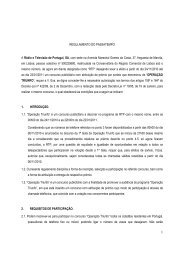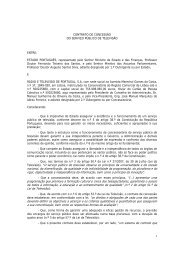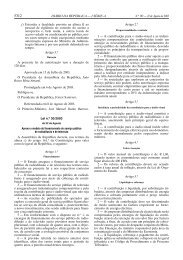6 Bases during the Cold War
6 Bases during the Cold War
6 Bases during the Cold War
You also want an ePaper? Increase the reach of your titles
YUMPU automatically turns print PDFs into web optimized ePapers that Google loves.
im around <strong>the</strong> huge Sino-Soviet Eurasian domain. Among <strong>the</strong> basing hostsdeveloped in addition to Egypt and Syria were Algeria, Guinea, Ghana, Congo-Brazzaville, Angola, Mozambique, Somalia, both Yemens, Iraq, Cuba andVietnam (Indonesia and India were both major Soviet arms clients by 1965, butprovided no significant access to bases).Gradually, <strong>the</strong> Soviet navy developed an external presence as <strong>the</strong> <strong>Cold</strong> <strong>War</strong>progressed, involving <strong>the</strong> build-up of a significant blue-water navy, <strong>the</strong> acquisitionof bases and available ports of call, and <strong>the</strong> compilation of “ship-days” in<strong>the</strong> major oceans and seas matching that of <strong>the</strong> U.S. Navy. As recently as <strong>the</strong>late 1950s, <strong>the</strong> Soviet navy had had little of “blue-water,” long-range power projectioncapability nor basing access. Indeed, <strong>the</strong> early postwar exceptions wereuse of a Chinese base at Port Arthur, one at Porkalla in Finland, and a three-yearinterregnum (1958–1961) when Soviet submarines were granted access toAlbanian bases in <strong>the</strong> Mediterranean.After that came <strong>the</strong> large-scale naval build-up through <strong>the</strong> late 1980s under<strong>the</strong> aegis of Admiral Gorshkov, a build-up that produced a navy that, measuredby major surface combatants and submarines, was larger than that of <strong>the</strong> U.S.The Soviet Navy fielded some 269 principal surface combatants (includingfour Kiev carriers), two ASW helicopter carriers, some 36 cruisers of which two(Kirov-class) were nuclear, 61 destroyers (of which 33 were specialized forASW) and 167 escorts including 100 corvettes.61 In addition, <strong>the</strong>re were some762 minor surface combatants: vast numbers of missile patrol boats, fast attackcraft, 372 principal auxiliary ships (replenishment, tankers, missile support,supply, cargo, submarine tenders, repair, hospital, submarine rescue, salvage/rescue, training ships, etc.). There were some 62 intelligence collection vessels(AGI), 456 naval research vessels, 74 tankers, 298 support ships, 1900 merchantships, and numerous civilian oceanographic, fishery, space-associated andhydrographic research vessels.62130 <strong>Bases</strong> <strong>during</strong> <strong>the</strong> <strong>Cold</strong> <strong>War</strong>İ 2007 Robert E. HarkavyThe Soviet submarine fleet was equally formidable, comprising some 360vessels. It fielded 63 SSBNs and 14 non nuclear-powered ballistic-missile submarines(SSNs), with a total of 983 submarine-launched ballistic missiles(SLBMs) – 39 SLBMs and 15 submarines were outside <strong>the</strong> SALT limits – some214 attack submarines of which 70 were nuclear-powered, and 63 cruise-missilesubmarines, 48 of which were nuclear (SSGNs).63That <strong>Cold</strong> <strong>War</strong> Soviet navy was, obviously huge. But its more limited (relativeto <strong>the</strong> U.S.) external basing network required an outsized force of auxiliaryships to compensate for <strong>the</strong> shortage of land bases. The same was true for AGIs,fishing and oceanographic vessels, and SIGINT, communications relay, spacetracking,ships etc.In <strong>the</strong> Mediterranean, <strong>the</strong> important Soviet presence in Syria included navalaccess to <strong>the</strong> port of Tartus, which was <strong>the</strong> primary maintenance facility forSoviet submarines operating in <strong>the</strong> area. A Soviet submarine tender, a yard oilerand a water tender were stationed <strong>the</strong>re.Over <strong>the</strong> years, <strong>the</strong>re had also been varied degrees of naval access to Algeria,Libya and Yugoslavia. Soviet submarines were reported serviced at Annaba inAlgeria, and its ships were refueled and maintained at a couple of Yugoslavports on <strong>the</strong> Adriatic, at Tivat and Sibenik.64In Guinea, despite some curtailment of long-maintained access for SovietBear reconnaissance aircraft, <strong>the</strong> USSR routinely used Conakry harbor as afacility for its West African patrol.65 But Luanda in Angola became <strong>the</strong> mostimportant port for Moscow’s West African naval units – since 1982 that hadinvolved an 8500-ton floating drydock capable of handling most major Sovietnaval combatants.66 In Ethiopia, <strong>the</strong> installation at Dahlak Archipelago was <strong>the</strong>maintenance facility and supply depot for Soviet naval combatants operating in<strong>the</strong> Indian Ocean and Red Sea, normally ranging from 20–25 units, includingsurface ships, attack and cruise-missile submarines and auxiliaries. This facilityincluded an 8500-ton floating drydock, floating piers, helipads, fuel and waterstorage, a submarine tender and o<strong>the</strong>r repair ships. Guided-missile cruisers andnuclear-powered submarines regularly called at Dahlak for repair and supplies.67In Cuba, in addition to enjoying access for port visits, maintenance, and soon, Moscow permanently based a submarine tender at Cienfuegos, used primarily,if not solely, for servicing attack submarines – access for SSBNs might havebeen construed as a violation of <strong>the</strong> agreements emerging out of <strong>the</strong> CubanPage 38
















